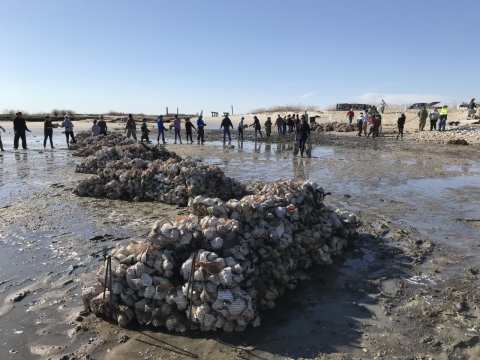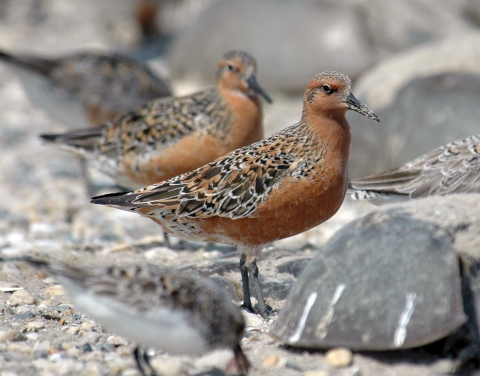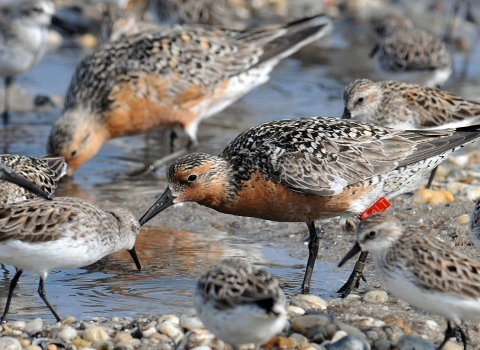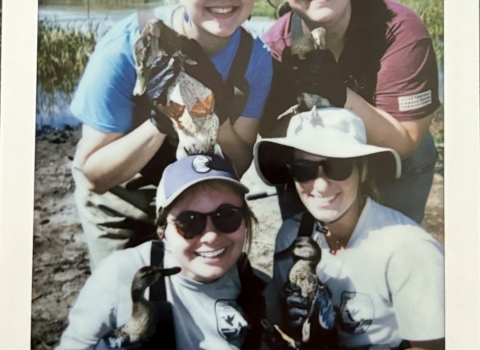Masters of aviation
Imagine jet-setting from Tierra del Fuego up to the Arctic, stopping at sunny, beautiful beaches along the way — sounds like a dream, doesn’t it? For the rufa red knot, a rusty-colored shorebird, it is a way of life. These masters of aviation may fly over 9,000 miles each way during their spring and fall migrations — sounding a little less like a vacation and a lot more like work, isn’t it?
Work is right, and an important source of the birds’ energy for these massive trips across the globe: tiny, blueish, horseshoe crab eggs, millions upon millions of them. These little eggs are a “calorie powerhouse,” says U.S. Fish and Wildlife Service biologist, Danielle McCulloch.
Although the rufa red knot cannot be tied directly to another species’ survival, or hailed as a keystone species for a habitat, they have every right to exist, and their survival is in our hands. The biggest threat to the species is anthropogenic, meaning human action which has resulted in warmer temps, rising sea levels and massive storms, is threatening these shorebirds.
Understanding this impact, the Service and partners have been hard at work tracking the birds on their long migrations to see where they stop, rest and recharge. This has been key to determining where work is focused to restore their habitat.
While we try to get a grip on climate change climate change
Climate change includes both global warming driven by human-induced emissions of greenhouse gases and the resulting large-scale shifts in weather patterns. Though there have been previous periods of climatic change, since the mid-20th century humans have had an unprecedented impact on Earth's climate system and caused change on a global scale.
Learn more about climate change and how to lessen its effects, the rufa red knot is going about its business of finding beaches to land and feed on. The problem is … some of those beaches are gone.
Superstorms sweep birds and sand out to sea
Massive storm systems, like 2012’s Hurricane Sandy, send high winds and waters to shores worldwide. Flooding rips into communities, destroying infrastructure and polluting waterways, while also stripping beaches of sand and disorienting migrating birds.
Service partner and wildlife biologist Larry Niles recalls the harrowing tale of one rufa red knot who found itself in a tropical storm — something becoming all too common on the Eastern Seaboard:
“We had a bird that was [tagged in] Delaware Bay and went up into the Arctic, then headed south. It went to Monomoy Wildlife Refuge [in Eastern Massachusetts] and then left to go to South America — hit a storm and was out 1,000 miles. It got blown out into the middle of the Atlantic Ocean, and then turned around and came back, before making its way to New Jersey and on to Brazil.”
Intense winds sent this bird — and presumably a flock along with it, since they don’t travel solo — out to sea. It was a dangerous situation, not only because our flighted friend could have been lost for good in those terrible winds, but the extended side trip certainly cost it precious time and energy. We will never know how many birds accompanied this one, or what number of them made it back to shore.
Given that the rufa red knot can fly such great distances, you may be thinking, “So what if you and your habitat are being swept away, find another beach, bird!” Not only are Delaware Bay beaches important pit stops for the birds on their journeys, they’re also prime locations for those little fuel packs mentioned earlier.
Horseshoe crabs spawn and lay eggs in tidal sand — the wet, soft sand where waves crash and run up the beach. After Sandy, not only was most of the sand missing, but our prehistoric pals had to run the gauntlet to reach what was left. A perilous path of rocks and nooks and crannies was waiting on the crabs. Given their shape is not unlike a turtle’s, if a crab flips over on its back, there’s not much it can do to right itself. So, aside from missing their sandy breeding grounds, the horseshoe crabs were getting stuck trying to reach someplace, anyplace, to lay their eggs — a pitiful sight, and a massive red flag for red knots.
On the move
Luckily, the Service and partners like the American Littoral Society were on the move, and fast. Planning began immediately, and projects to restore beaches in New Jersey were underway within a few months. Sand was and continues to be reintroduced to the habitat.
In an effort known as a “shell-ebration,” partners placed breakwaters made of shells just off the re-created beaches. These barriers have strategic gaps for the horseshoe crabs to pass through safely but keep the worst of the waves from running off with the sand.
“Shell-ebrate” good times, come on!
Once conservationists understood the bigger picture after “Superstorm Sandy,” they realized they would need not only the support of the community but also their direct help.
“We really worked hard to engage the communities — we got them involved in the work. It strengthened their own connection to the bay through a conservation lens but also helped them see the benefits that [this work] could bring to the rest of their lives," says Tim Dillingham, executive director for the American Littoral Society.
Locals depend on the bay, whether they make their incomes from the fishing industry or tourism, or simply enjoy birdwatching and the surf washing over their feet — people need each other and the restoration of this ecosystem. And much like the horseshoe crabs that make landfall here every year, “the local community is hardy,” says Dillingham.
Locals drove dump trucks full of sand to deposit back on the beaches. They helped create breakwaters by packing 25,000 bags with shells. The Service taught partners to drive the swamp buggies, or “marsh masters,” needed to haul the shells for the breakwaters. Captain Al Modjeski, habitat restoration director for the American Littoral Society, recounts excitedly, “Within two months of restoring the beaches, the horseshoe crabs were back.” And laying eggs — giving rufa red knots a well-needed boost!
The collaborative effort between the community, partners, and the Service was immense, and the investment continues.
The American Littoral Society has been a primary partner in the effort to bring back beaches, receiving Service grants through the Delaware Watershed Conservation Fund from 2018-2021.
They will be hauling sand to make new beaches later this year. Dillingham and Modjeski value and understand the importance of connecting and building a relationship with the community. After such tremendous loss and hardship, it’s imperative that people know the Service and our partners are — and will continue to be — there to help.
“We haven't abandoned them; we aren't leaving; and we haven't left since Sandy," says Modjeski.
That commitment will endure.
What’s next?
The Service is receiving funding for ecosystem restoration through the Bipartisan Infrastructure Law Bipartisan Infrastructure Law
The Bipartisan Infrastructure Law (BIL) is a once-in-a-generation investment in the nation’s infrastructure and economic competitiveness. We were directly appropriated $455 million over five years in BIL funds for programs related to the President’s America the Beautiful initiative.
Learn more about Bipartisan Infrastructure Law . This places a significant chunk of money into the hands of those who are tirelessly working to save species like the rufa red knot and its nearby avian friend, the saltmarsh sparrow. Funding will have lasting positive effects on local communities as well.
With efforts focused on community resilience, clean water, flood mitigation, and access to beautiful beaches, we know this work is good for body and mind. After all, the healthier a beach, and the salt marsh salt marsh
Salt marshes are found in tidal areas near the coast, where freshwater mixes with saltwater.
Learn more about salt marsh beyond, the more protected nearby homes and businesses are from flood damage.
The successes demonstrated in this beach restoration effort pave the way for the next step — re-establishing healthy salt marsh ecosystems just beyond the shore, but that, is another story . . .
https://www.fws.gov/story/saltmarsh-sparrows-need-help-surviving-rising-tides












